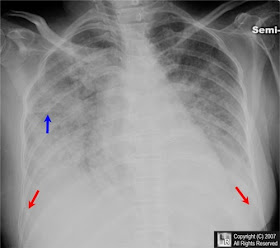 Pulmonary Alveolar Edema. There is extensive, bilateral airspaces disease with fluid in the minor fissure (blue arrow) and bilateral pleural effusions (ref arrows). Although the heart is not enlarged, the cause was still on a cardiogenic basis.
Pulmonary Alveolar Edema. There is extensive, bilateral airspaces disease with fluid in the minor fissure (blue arrow) and bilateral pleural effusions (ref arrows). Although the heart is not enlarged, the cause was still on a cardiogenic basis.Cardiogenic and Non-cardiogenicPulmonary Edema
General Considerations
Increase in the fluid in the lung
Generally, divided into cardiogenic and non-cardiogenic categories.
Congestive heart failure is the leading diagnosis in hospitalized patients older than 65
Pathophysiology
Fluid first accumulates in and around the capillaries in the interlobular septa (typically at a wedge pressure of about 15 mm Hg)
Further accumulation occurs in the interstitial tissues of the lungs
Finally, with increasing fluid, the alveoli fill with edema fluid (typically wedge pressure is 25 mm Hg or more)
Causes
Cardiogenic pulmonary edema.
Heart failure
Coronary artery disease with left ventricular failure.
Cardiac arrhythmias
Fluid overload -- for example, kidney failure.
Cardiomyopathy
Obstructing valvular lesions -- for example, mitral stenosis
Myocarditis and infectious endocarditis
Non-cardiogenic pulmonary edema -- due to changes in capillary permeability
Smoke inhalation.
Head trauma
Overwhelming sepsis.
Hypovolemia shock
Re-expansion
By drainage of a large pleural effusion with thoracentesis
Of the lung collapsed by a large pneumothorax
High altitude pulmonary edema
Disseminated intravascular coagulopathy (DIC)
Near-drowning
Overwhelming aspiration
Heroin overdose
Adult (acute) respiratory distress (deficiency) syndrome (ARDS)
Clinical syndrome consisting of
Pulmonary edema associated with severe respiratory distress
Cyanosis refractory to oxygen administration
Decreased lung compliance
Lower pulmonary capillary wedge pressure (PCW <>
No comments:
Post a Comment